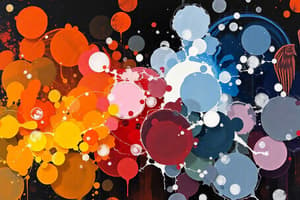Podcast
Questions and Answers
Which of the following items is a mixture? (Select all that apply)
Which of the following items is a mixture? (Select all that apply)
- Water
- None of the above
- Sugar
- Helium
- Brass (correct)
Which of the following is a homogeneous mixture? (Select one)
Which of the following is a homogeneous mixture? (Select one)
- Molten iron
- Stainless steel (correct)
- Trail mix
- None of the above
- Water
How would you classify sugar? (Select one)
How would you classify sugar? (Select one)
- Pure substance - element
- None of the above
- Mixture - homogeneous
- Mixture - heterogeneous
- Pure substance - compound (correct)
Physical properties are: (Select one)
Physical properties are: (Select one)
What is the correct formula for a potassium ion with 18 electrons?
What is the correct formula for a potassium ion with 18 electrons?
An isotope represented as S-34: (Select one)
An isotope represented as S-34: (Select one)
A specific isotope of an element is known to have 15 protons and 16 neutrons. Which symbol would properly represent this isotope?
A specific isotope of an element is known to have 15 protons and 16 neutrons. Which symbol would properly represent this isotope?
An atom containing 7 protons, 8 neutrons, and 7 electrons: (Select one)
An atom containing 7 protons, 8 neutrons, and 7 electrons: (Select one)
Which of the following statements is FALSE? (Select one)
Which of the following statements is FALSE? (Select one)
All of the following can be considered physical properties EXCEPT: (Select one)
All of the following can be considered physical properties EXCEPT: (Select one)
Which of the following items is a physical property? (Select one)
Which of the following items is a physical property? (Select one)
Which of the following elements has only 12 protons?
Which of the following elements has only 12 protons?
Which one of the following is a main-group element?
Which one of the following is a main-group element?
Isotopes are: (Select one)
Isotopes are: (Select one)
How many neutrons are present in C-14?
How many neutrons are present in C-14?
When elements combine to form compounds: (Select one)
When elements combine to form compounds: (Select one)
How many oxygen atoms are in the formula Al2(CO3)3?
How many oxygen atoms are in the formula Al2(CO3)3?
Which among the following elements does NOT exist as a diatomic molecule in nature? (Select one)
Which among the following elements does NOT exist as a diatomic molecule in nature? (Select one)
The ionic compound that forms between potassium and oxygen is: (Select one)
The ionic compound that forms between potassium and oxygen is: (Select one)
What is the correct name of the compound whose formula is BF3?
What is the correct name of the compound whose formula is BF3?
What is the name of HNO2?
What is the name of HNO2?
Flashcards are hidden until you start studying
Study Notes
Mixtures and Pure Substances
- Brass is classified as a mixture, specifically an alloy.
- Stainless steel is a homogeneous mixture composed of iron and carbon.
- Sugar is identified as a pure substance and categorized as a compound.
Physical Properties and Ions
- Physical properties are traits exhibited by a substance without altering its chemical composition.
- A potassium ion with 18 electrons is denoted as K+.
- Isotopes, such as S-34, contain varying numbers of neutrons; S-34 has 18 neutrons.
- The isotope with 15 protons and 16 neutrons is represented as P (Phosphorus).
- An atom with 7 protons, 8 neutrons, and 7 electrons possesses no overall charge, making it neutral.
Statements about Matter
- A pure substance can either be an element or a compound, and all statements about variations in substances are deemed true.
- Flammability is not classified as a physical property, unlike taste, density, boiling point, and color.
- The odor of spearmint gum exemplifies a physical property.
Elements and Main-Group Classification
- Magnesium (Mg) is defined by having 12 protons.
- Cesium (Cs) is a notable main-group element among the options provided.
- Isotopes consist of atoms that differ in neutron count while maintaining the same element identity.
Neutrons and Compounds
- Carbon-14 (C-14) contains 8 neutrons.
- When elements form compounds, their intrinsic properties are transformed.
- The chemical formula Al2(CO3)3 comprises 9 oxygen atoms.
Diatomic Molecules and Ionic Compounds
- Neon is the sole element listed that does not exist as a diatomic molecule in nature.
- The ionic compound resulting from the interaction between potassium and oxygen is K2O.
- Boron trifluoride is the correct name for the compound with the chemical formula BF3.
- Nitrous acid corresponds to the chemical formula HNO2.
Studying That Suits You
Use AI to generate personalized quizzes and flashcards to suit your learning preferences.




